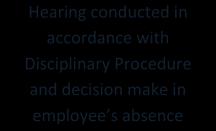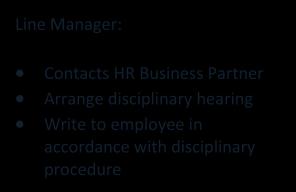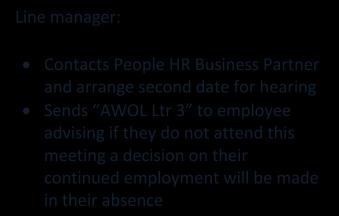

ABSENCE WITHOUT LEAVE (AWOL)
Policy and Procedure
Version: V1
Ratified by: People, Culture and Remuneration Committee
Date ratified: 24/05/2022
Job Title of author: Human Resources
Reviewed by Committee or Expert Group Staff Partnership Forum
Equality Impact Assessed by:
Related procedural documents

HR Business Partner
HRPOL14 Disciplinary Policy
HRPOL15 Grievance Policy
HRPOL17 Special Leave
HRPOL24 Annual Leave Policy
HRPOL26 Psychological Wellbeing of Staff Policy
HRPOL27 Workforce Solutions Bank Policy
HRPOL31 Attendance Management Policy
HSPOL21 Working Remotely and Home as Base Policy
HSPOL19 - Lone Working Policy
Review date: May 2025

It is the responsibility of users to ensure that you are using the most up to date document – i.e. obtained via the intranet.

In developing/reviewing this policy Provide Community has had regard to the principles of the NHS Constitution.

Version Control Sheet
Version Date Author Status Comment V1 May 2022 HR Business Partner Ratified New


1. INTRODUCTION
1.1 The Provide Group aims to deliver high quality and safe services and it recognises that this commitment to quality and safety must be reflected in the work and conduct of all its employees.
1.2 This policy and procedure regarding Absence Without Leave (AWOL) applies to all employees. It is to be used if an employee fails to comply with Provide CIC’s Attendance Management Policy, (or provide the necessary evidence within the required time period), fails to attend work, to be available for work when working remotely or from home, to return to work after a holiday, or is absent from work for any other reason without permission.
2. SCOPE
2.1 This policy and procedure applies to all employees at the Provide Group. It excludes employees who are within their probationary period of service (refer to the Probationary Procedure) and Medical and Dental Staff, who are subject to the provision of circular HSC2003/012 entitled “Maintaining High Professional Standards in the Modern NHS”, (or any guidance that supersedes it).
2.2 Workforce Solutions workers (on zero hours/ flexi/bank contracts) who do not come into work when expected should be contacted in line with the first two steps of the procedure. If no contact is made then the manager should contact their HR Business Partner
2.3 Volunteers who do not come into work when expected should be contacted in line with the first two steps of the procedure. If no contact is made then the manager should contact the Volunteer Manager
3. KEY PRINCIPLES
3.1 All cases of absence without leave (AWOL) should be investigated at the earliest opportunity to ensure the wellbeing of the member of staff as well as to address any operational staffing concerns without delay.
3.2 It is essential to explore the reason for any absences with care and compassion to understand why the employee has not attended work as expected (or has not been available for work if working remotely/ from home). If, however, the employee is absent from work without good cause and/or fails to properly and effectively notify the Organisation of their absence, this may be treated as a disciplinary offence up to and including Gross Misconduct (please refer to the Disciplinary Procedure).

3.3 If an employee has been given formal advice by an appropriate authority (e.g. including but not limited to Doctor, Government, or other professional body) to self-isolate/ quarantine/ shield, they should ensure that they adhere to that advice and that they also remain in telephone contact with their manager as appropriate. Failure to follow the formal advice will be investigated and may constitute Absence Without Leave/ Gross Misconduct.
3.4 In some cases, failure to be available for work (particularly if concealing the fact or if found to be working elsewhere) may constitute fraud. Advice should be sought from HR and from the Provide Group Fraud Manager.
4. KEY RESPONSIBILITIES
4.1 Employees
Employees are expected to: -
• Advise their line manager if they are unable to come into work for any reason
• Gain agreement from their manager if they are working from home and need to take time away from work
• Comply with other policies and procedure such as Attendance Management, Annual Leave etc.
4.2 Managers
Managers are responsible for raising awareness of this policy within their own business units and will highlight changes to their teams at meetings. In addition, they are expected to:
• Primarily be concerned about the employee’s welfare
• Contact employees on the first day of absence
• Ensure that the process below is followed consistently and that absence without leave is not allowed to continue unaddressed
• Keep their HR Business Partner updated
• Use the letter templates available

4.3
Group Chief Officers
All Group Chief Officers are responsible for identifying and ensuring the development of documents relevant to their area of responsibility. The Group Chief People Officer is accountable to the Group Chief Executive and the Provide CIC Board for ensuring this policy is implemented and associated documents become active documents within the Provide Group
Group Chief Officers will ensure that this policy is appropriately consulted upon and that all resource implications are highlighted and funding identified. They will ensure that their Senior Managers are informed of progress.
4.4
Group Chief Executive
The Group Chief Executive has overall responsibility for the strategic and operational management of the Provide Group which includes ensuring that this policy & associated documents comply with all legal and statutory requirements.
4.5 The Provide CIC Board
The Provide CIC Board is responsible for setting the strategic context in which organisational documents are developed, and for ensuring the formal review and approval of documents takes place.
5. PROCEDURE / IMPLEMENTATION
5.1 Action on first day of absence
On the first day of absence (if the employee does not turn up for work, call to say that they are going to be absent or fails to return from a period of authorised leave), the manager will attempt to contact them by telephone, making a note of the attempt and the time/date. Consideration should be given by the line manager as to whether this behaviour is very unusual for the individual concerned.
• If the employee does not answer the telephone, the manager will attempt to leave a voicemail, if this facility is available. The manager should ask the employee to return their call and also advise them that the manager will try again tomorrow if no contact is received. If the manager is unable to contact the employee, they should attempt to contact the employee's next of kin or listed emergency contact in order to enquire as to the employee’s wellbeing
• If no contact is made by the end of the day, the manager should contact their HR Business Partner to alert them of the situation. The manager should complete a P3 Form, stating that the employee is currently “Absent Without Leave” and that their “pay should be temporarily suspended in line with Paragraph 5 of the AWOL Procedure”. The P3 should be sent to the Finance in-box (provide.finance@nhs.net). After Finance has authorised this, they will forward the form to Payroll to be actioned and to the HR Admin team to be stored on file. The manager should confirm this by sending template “AWOL

Ltr 1 – Letter of Concern” to the employee and sending a copy to the generic HR inbox - hr.provide@nhs.net to be stored on file.
• If the manager is aware of any mental health problems or other personal issues that may have impacted or led to the absence and/or is seriously concerned for the individual’s welfare, the manager should discuss this with the HR Business Partner. If no emergency contacts are available and the manager is aware that the employee lives alone, consideration may be given to someone visiting the individual’s home address or calling the police/social services (depending on the circumstances)
• If the employee answers the call and says that they are sick then the manager should ask about any action that is being taken (e.g. doctor’s visit), discuss the expected date of return, discuss alternative work they could be doing (if appropriate), agree when the employee will next contact the manager (minimum weekly if mid-term absence, bi-weekly if longer absence) and remind the employee of the importance of following the Attendance Management Policy. A record should be made of this conversation and should be placed on file, and it should be discussed at the Return to Work Interview.
• If the employee answers the call and advises that they are resigning with immediate effect, the manager should explore the situation and consider whether a “cooling off period” may be appropriate. For example, if the employee raises any concerns regarding their employment it may be appropriate to put a hold on their resignation whilst an investigation is conducted. It is essential to establish whether the employee is resigning of their own free will, or if they feel that they have no other option but to do so.
If the employee raises any such concerns, advice should immediately be sought from the HR Business Partner or the Generic HR inbox - hr.provide@nhs.net
• If there appears to be no concerns and the employee is content with their decision to resign, the manager should send a letter to the employee confirming their conversation and the fact that they are accepting their resignation. The manager must send a Leaver’s form to notify Finance immediately to ensure that no overpayments are made.
5.2 Action on second working day of absence
On the second day of absence (where an employee was due to be at work), if nothing has been heard from the employee and the manager has again been unable to contact them and has not received a satisfactory explanation from the employee’s next of kin or emergency contact, the manager will telephone the employee again to try to establish contact.
If they are unable to make contact by the end of the day, the manager will write to the employee (using the template “AWOL Ltr 2 – Continued AWOL”) detailing their absence and the attempts to make contact. The letter will say that the manager is concerned as no satisfactory explanation for the absence has been received and will require that the employee contacts the manager as soon as possible, but no later than 3 [three] working days after the date of the letter. This should be sent recorded delivery.
The letter will warn the employee that, if they fail to make contact by the deadline, the Organisation may take disciplinary action. The manager should ensure that they

update their HR Business Partner and send a copy to the generic HR inbox –hr.provide@nhs.net to be stored on file.
5.3 Further action on the fifth working day of absence
If, following the deadline the employee has still not turned up for work or contacted their manager, the manager should compile the information gathered so far into a preliminary investigation report and this should be reviewed with HR and the Senior Manager (Director, Assistant Director, Deputy Director, Head of Service or equivalent). This report should be clearly written and as comprehensive as possible outlining whether there are any further lines of enquiry needed.
5.4 Disciplinary action
The Senior Manager may decide that a formal investigation is needed if there are additional factors that need to be explored (for example but not limited to: concerns or grievances that have previously been raised, allegations of the employee working elsewhere (potential fraud) etc). If, however the case is clear, there may be no need for a formal investigation and the manager will be advised to send the employee a letter inviting them to attend a disciplinary hearing to explain their absence (using the standard Disciplinary Invite letter). The letter should warn the employee that the lack of an adequate explanation could result in summary dismissal for gross misconduct, a copy should be sent to the HR Business Partner/ generic HR inboxhr.provide@nhs.net. This should be sent by recorded delivery.
If the employee fails to attend the disciplinary hearing it is best practice for the line manager to still hold the hearing and, during that time, the line manager will try to contact the employee by telephone, and will try to contact the emergency contact if needed to establish whether there is some reason why the employee could not attend (in line with the Provide Group values of Care and Compassion). The manager should make sure that a record is kept of these proceedings.
If no contact is made, the manager should inform the HR Business Partner and write to the employee again, inviting them to a second disciplinary hearing (using letter template “AWOL Ltr 3 – Invite to Final Disciplinary Hearing”). This letter will inform the employee that, if they fail to attend this second disciplinary hearing and they fail to offer any reasonable explanation for their non-attendance, the hearing will continue and a decision on their continued employment will be made in their absence.
5.5 If the employee returns to work
If the manager contacts the employee successfully and/or the employee returns to work, the manager should conduct an immediate investigation into the reasons for their absence and their lack of contact with the Organisation.
If the employee can give adequate explanations for their absence and lack of contact, the manager can conduct a return-to-work interview. If the employee is unable to provide an adequate explanation for their absence and lack of contact, the Organisation may treat the absence and the failure to follow the reporting procedure as a disciplinary matter. In this case, the manager will seek advice from HR and their Senior Manager.

If the employee claims to have been sick (to the extent that this also precluded contacting the Organisation), the manager can ask for reasonable evidence of this. If the employee is unable to provide sufficient evidence, the Organisation may consider whether or not the claimed sickness absence was genuine or whether it is reasonable to believe that contact could and should have been made
If the manager considers the employee's failure to attend work to be potential gross misconduct, the manager will compile the evidence into a preliminary investigation report which should be reviewed by HR and the Senior Manager, who may commission a formal investigation (if further details are required) or instigate a disciplinary hearing in accordance with its disciplinary procedure.
5.6 Unauthorised leave after a resignation.
If an employee has handed in their resignation and is then subsequently absent without leave, they are still technically in breach of contract, as they are contractually obliged to give notice; however, it may be appropriate to take a more pragmatic approach. All reasonable attempts should be made to contact the employee to establish why they have not come in to work, and to establish whether there is any reason for concern. If the employee is not contactable and no contact has been made through the emergency contact, the manager should discuss the matter with HR who may advise the manager to write to the employee to confirm that they have accepted the resignation with effect from the last date that they worked. This should be sent via recorded delivery.
5.7 Unauthorised annual leave
As per Paragraph 10 of the Annual Leave and Bank Holiday Procedure, employees must ensure that all annual leave requests have been approved by their line manager before they take their leave. If an employee has been refused a request for annual leave (in line with that procedure), but declares that they intend to take the time off anyway, the employee's manager should inform their HR Business Partner and write to the employee instructing them to attend work (using Letter Template “AWOL Ltr 4 –Refused Holiday Request”). The letter should confirm that:
• the leave request (for the specific dates) was legitimately declined in line with paragraph 10 of the Annual Leave and Bank Holiday Procedure;
• the employee is expected to attend work as usual; and
• failure to do so will be Absence Without Leave (AWOL), be unpaid and may result in disciplinary action, which could result in summary dismissal for gross misconduct.
The letter should invite the employee to reconsider their expressed intention to be absent. This should be sent recorded delivery and a copy should be sent to the generic HR inbox - hr.provide@nhs.net to be stored on file.
If, having sent this letter, the employee fails to attend work; the manager should treat the absence as unauthorised. If an employee has been refused a request for annual leave, but fails to attend work (either by saying that they are sick or by making no contact), the Organisation will investigate this as a potential Absence Without Leave (AWOL).

5.8 In situations where an employee has gone missing part way through their shift.
A designated staff member, should attempt to track the employee’s movements by checking their diary, re-tracing their movements or client list for the day (i.e. check with colleagues or ring round their patients to see if they have visited).
If after doing this, concerns still remain then the Service Lead should be contacted who should then contact the staff member’s next of kin to ascertain when they last had any contact.
If, after exhausting the above, the Service Lead is unable to contact the lone worker, the Manager should contact Carecall on 0300 003 0683 and advise the call handler that they are unable to locate a member of staff.
Carecall are then able to obtain a location fix and contact the staff member via their work phone, mobile phone or lone working device. If contact is not made and based on the seriousness of the situation the matter should be escalated to the Manager on call who will then decide on what the next step should be.
This could include contacting the Police, who are happy to act on a ‘missing person’ with immediate effect, providing the organisation has made every effort to trace the person concerned, and can justify their cause for concern.
6. MONITORING AND REVIEW
6.1 This policy will be reviewed at least every 3 years in line with the Policy for the Management of Procedural Documents, or more frequently in line with any requirements relating from legislative changes.
6.2 Review will be undertaken by a CIPD registered member of the HR Department and monitoring will be conducted in respect of policy outcomes. The need for improvement or clarification may be identified as lessons learnt, through using the process and where appropriate amendments will be made.
7. ABSENCE WITHOUT LEAVE PROCESS FLOW CHART


Absence Without Leave (AWOL) Process Flow Chart













































































































































































































Appendix A :
EQUALITY IMPACT ASSESSMENT TEMPLATE: Stage One: ‘Screening’
Name of project/policy/strategy (hereafter referred to as “initiative”):
Absence Without Leave (AWOL) Policy & Procedure
Provide a brief summary (bullet points) of the aims of the initiative and main activities:
To Guide managers through the process of addressing absence without leave so that all such matters can be dealt with consistently
To ensure that such absence is address promptly, complying with our duty of care for the employee and with our duty not to waste Provide Group funds
To help managers consider the many reasons why an employee may be absent
Project/Policy Manager:
Anwen Walkerdine

Date:24.09.2020
This stage establishes whether a proposed initiative will have an impact from an equality perspective on any particular group of people or community – i.e. on the grounds of race (incl. religion/faith), gender (incl. sexual orientation), age, disability, or whether it is “equality neutral” (i.e. have no effect either positive or negative). In the case of gender, consider whether men and women are affected differently.
Q1. Who will benefit from this initiative? Is there likely to be a positive impact on specific groups/communities (whether or not they are the intended beneficiaries), and if so, how? Or is it clear at this stage that it will be equality “neutral”? i.e. will have no particular effect on any group.
Employees with mental health concerns will be contacted promptly, compassionately and will be reminded of their ability to access the EAP Helpline
Q2. Is there likely to be an adverse impact on one or more minority/under-represented or community groups as a result of this initiative? If so, who may be affected and why? Or is it clear at this stage that it will be equality “neutral”?
Neutral
Q3. Is the impact of the initiative – whether positive or negative - significant enough to warrant a more detailed assessment (Stage 2 – see guidance)? If not, will there be monitoring and review to assess the impact over a period time? Briefly (bullet points) give

reasons for your answer and any steps you are taking to address particular issues, including any consultation with staff or external groups/agencies.
This does not warrant a more detailed assessment. All employees are equally expected to and should be able to maintain contact with their manager. Where particular health concerns are identified the policy prompts the manager to think about the support required. In all cases, and especially with known health concerns, the Provide Group has a duty of care to the employees and should not ignore cases of unauthorised absence.
Guidelines: Things to consider
• Equality impact assessments at the Provide Group take account of relevant equality legislation and include age, (i.e. young and old,); race and ethnicity, gender, disability, religion and faith, and sexual orientation.
• The initiative may have a positive, negative or neutral impact, i.e. have no particular effect on the group/community.
• Where a negative (i.e. adverse) impact is identified, it may be appropriate to make a more detailed EIA (see Stage 2), or, as important, take early action to redress this – e.g. by abandoning or modifying the initiative. NB: If the initiative contravenes equality legislation, it must be abandoned or modified.
• Where an initiative has a positive impact on groups/community relations, the EIA should make this explicit, to enable the outcomes to be monitored over its lifespan.
• Where there is a positive impact on particular groups does this mean there could be an adverse impact on others, and if so can this be justified? - e.g. are there other existing or planned initiatives which redress this?
• It may not be possible to provide detailed answers to some of these questions at the start of the initiative. The EIA may identify a lack of relevant data, and that data-gathering is a specific action required to inform the initiative as it develops, and also to form part of a continuing evaluation and review process.
• It is envisaged that it will be relatively rare for full impact assessments to be carried out at the Provide Group. Usually, where there are particular problems identified in the screening stage, it is envisaged that the approach will be amended at this stage, and/or setting up a monitoring/evaluation system to review a policy’s impact over time.
EQUALITY
IMPACT ASSESSMENT TEMPLATE: STAGE 2:
(To be used where the ‘screening phase has identified a substantial problem/concerns)
This stage examines the initiative in more detail in order to obtain further information where required about its potential adverse or positive impact from an equality perspective. It will help inform whether any action needs to be taken and may form part of a continuing assessment framework as the initiative develops.
Q1. What data/information is there on the target beneficiary groups/communities? Are any of these groups under- or over-represented? Do they have access to the same resources? What are your sources of data and are there any gaps?

Q2. Is there a potential for this initiative to have a positive impact, such as tackling discrimination, promoting equality of opportunity and good community relations? If yes, how? Which are the main groups it will have an impact on?
Q3 Will the initiative have an adverse impact on any particular group or community/community relations? If yes, in what way? Will the impact be different for different groups – e.g. men and women?
Q4. Has there been consultation/is consultation planned with stakeholders/ beneficiaries/ staff who will be affected by the initiative? Summarise (bullet points) any important issues arising from the consultation.
Q5. Given your answers to the previous questions, how will your plans be revised to reduce/eliminate negative impact or enhance positive impact? Are there specific factors which need to be taken into account?

Q6. How will the initiative continue to be monitored and evaluated, including its impact on particular groups/ improving community relations? Where appropriate, identify any additional data that will be required.
Guidelines: Things to consider
• An initiative may have a positive impact on some sectors of the community but leave others excluded or feeling they are excluded. Consideration should be given to how this can be tackled or minimised.
• It is important to ensure that relevant groups/communities are identified who should be consulted. This may require taking positive action to engage with those groups who are traditionally less likely to respond to consultations, and could form a specific part of the initiative.
• The consultation process should form a meaningful part of the initiative as it develops, and help inform any future action.
• If the EIA shows an adverse impact, is this because it contravenes any equality legislation? If so, the initiative must be modified or abandoned. There may be another way to meet the objective(s) of the initiative.
Further information:
Useful Websites
www.equalityhumanrights.com Website for new Equality agency www.employers-forum.co.uk – Employers forum on disability www.disabilitynow.org.uk – online disability related newspaper www.womenandequalityunit.gov.uk – Gender issues in more depth www.opportunitynow.org.uk - Employer member organisation (gender) www.efa.org.uk – Employers forum on age www.agepositive.gov.uk – Age issues in more depth
© MDA 2007
EQUALITY IMPACT ASSESSMENT TEMPLATE: Stage One: ‘Screening’
